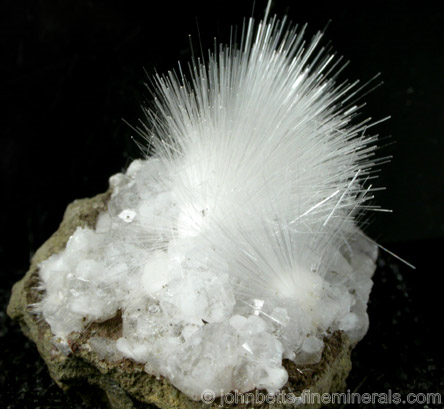The Mineral mesolite

Mesolite is a fragile member of the zeolite group, and forms almost exclusively in delicate, needle-like crystal habits. It is closely related to Natrolite and
Scolecite, and can appear very similar to them. Chemical analysis or
optical tests are sometimes required to distinguish Mesolite from Natrolite and Scolecite, and a single
crystal may even contain part of each mineral within different zones of the
same crystal.
Mesolite is a very brittle and is easy
broken, so care should be exercised when handling specimens. Mesolite is named after the Greek term "Mesos", which means "middle", and "Lithos" - stone. It is named so because Mesolite is intermediary in a series between Natrolite and Scolecite.
Chemical Formula
Na2Ca2Al6Si9O30 · 8H2O
Color
White, colorless, off-white, light yellow.
Crystal System
Monoclinic
Properties
Streak
Colorless |
Hardness
5 |
Transparency
Transparent to translucent |
Specific Gravity
2.3 |
Luster
Silky |
Cleavage
1,2 |
Fracture
Uneven |
Tenacity
Brittle |
Crystal Habits
In acicular and radial groupings, often with fine individual slender crystals protruding from the grouping. Also as fillings inside vugs and as rounded, globular masses which often have spiky protrusions.
Uses
Mesolite specimens are of interest to collectors, especially those specializing in zeolite minerals.
Noteworthy Localities
Worldwide localities of Mesolite include Talisker Bay, Isle of Skye, Scotland; Haldarsvik, Streymoy island, Faroe Islands (Denmark); and Hvalfjordur, Iceland. Mesolite is less common than other zeolites in the Indian basalts of Maharashtra, but it does occur in nice acicular crystals in Pune (Poona); and a new important find of light yellow balls is noted from Kannad, Aurangabad District.
In the U.S., beautiful sprays of large individual Mesolite crystals have come from the Skookumchuck Dam, Bucoda, Thurston Co., Washington. This locality has produced the largest crystals of this mineral yet. Delicate Mesolite sprays come from Oregon at Bear Creek Quarry, Drain, Douglas Co.; and at Ritter Hot Springs, Grant Co. Small sprays associated with Chabazite are found in the SA Canyon, Gila River, Grant Co., New Mexico. The traprocks of Northern New Jersey are well-known Natrolite producers, but Mesolite is also represented at all the important localities. However, it is often overlooked as Natrolite and labelled as such, due to the difficulty in determining the exact specimen type.
Distingushing Similar Minerals
Mesolite can be virtually impossible to distinguish from Natrolite.